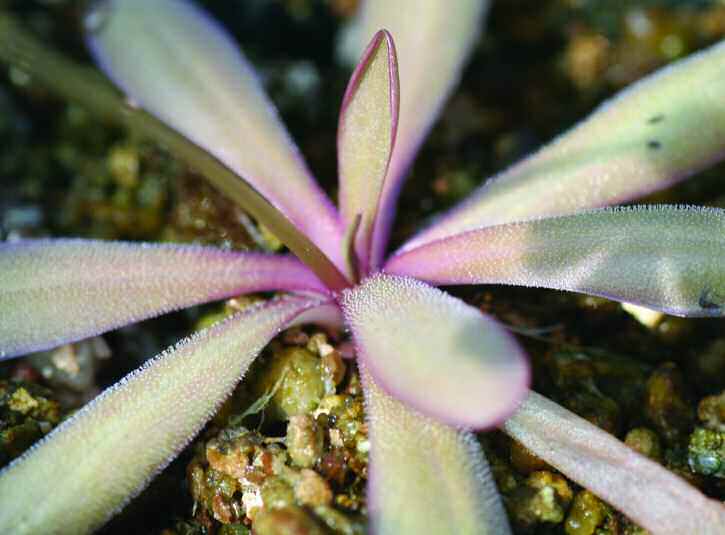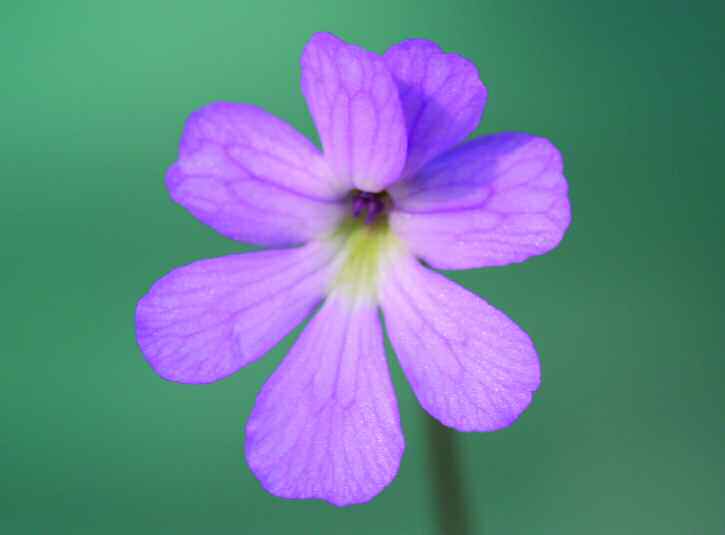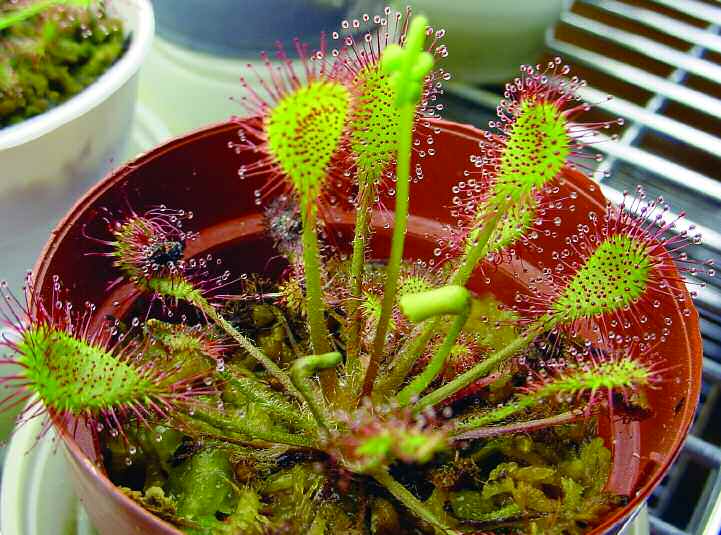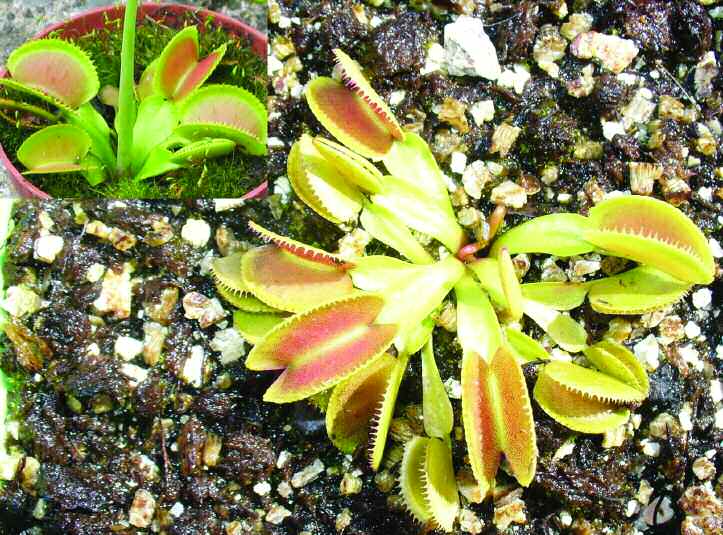Carnivorous Plant Newsletter
Volume 37, Number 1,
March 2008, pages 22 - 26
NEW CULTIVARS
Dionaea 'Microdents'
Drosera 'Ivan's Paddle'
Pinguicula 'Down Under'
Pinguicula 'Down Under'
Submitted: 6 April 2007
This hybrid was created by me in 2001, by crossing a red-leafed clone of Pinguicula emarginata and Pinguicula moctezumae. The plant that I selected from the progeny is homophyllous, although its carnivory is minimal during winter. About two years ago I decided to name this plant “Down Under” in gratitude to my adoptive country Australia.
Under good conditions the plant has between 10-12 leaves when in active growth. Its leaves are narrowly linear, up to 1 cm wide and 6 cm long (see Figure 1). They are green-purplish but are dark purple at the base. This leaf colour is present even in a shady situation but the purple colour intensifies in sunnier positions. The outstanding leaf color is a major reason I believe cultivar registration is warranted for this clone.
Flowers are uniformly pale mauve and unscented (see Figure 2). The five petals are about 1 cm long. The upper petals are about 8 mm wide and 8 mm long (measured from the petal tip to the point of fusion between them). The two lower lateral petals are 6 mm wide and 10 mm long from the tip of the petals to the point where they fuse with the lower central petal. The lower central petal is about 8 mm wide and approximately 12 mm long, measured from its tip to its points of fusion with the lower lateral petals. All the petals are square-tipped and reticulated with darker veins.
The corolla has a cream to yellowish ring extending from the lower part of the corolla up to the apron-like dark purple lobe of the stigma. This ring does not continue above the stigmatic lobe. The spur is 20 mm long, angled approximately 12° to the pedicel.
The main flowering time is from early spring to early winter, but flowering can occur throughout the year. Each plant may have as many as three flowers blooming at the same time, and they last up to three weeks.
Like both of its parents, Pinguicula ‘Down Under’ responds well to permanently moist to wet conditions. Propagation is readily achieved by vegetative means.
—-HELMUT KIBELLIS • Castle Hill • New South Wales • Australia

Figure 1: Pinguicula ‘Down Under’ leaf rosette.

Figure 2: Pinguicula ‘Down Under’ in flower. This atypical flower has seven petals, usually the flowers only have five petals.
Drosera 'Ivan's Paddle'
Submitted: 24 July 2007
The paddle-leaved sundew (Drosera × obovata)1, as author Adrian Slack calls it, is quite a familiar plant. It gets its name from leaves which are the shape of old-fashioned canoe paddles. The common natural hybrid is ever present wherever the two parent species, D. anglica and D. rotundifolia, are found growing together. Its great range extends throughout the boreal region encircling the Earth in the northern latitudes. This range also extends into temperate latitudes as in northern California where I first encountered it. Slack describes this sundew as “surpassing the English sundew (D. anglica) in size and magnificence”. I was smitten. This new unique cultivar of the hybrid was originally created by cross pollination in July of 2001.
The cultivar name needs explanation. In the past I would label my pots with the common names such as round-leaved sundew or paddle-leaved sundew, for those less technically oriented. People at our local Los Angeles Carnivorous Plant Society (LACPS) meetings getting a specimen of this hybrid clone from me relabeled it “Ivan’s paddle-leaf.” This became streamlined to Ivan’s paddle (see Figure 3). Now, I do like the name, but an embarrassing glitch dawned on me only after the plant had gone around the world and the name was stuck: One day at an LACPS meeting a woman leaning over a bunch of potted plants on the table exclaimed, “I’d like a little paddle”. The rest, as they say, is history.
This new cultivar is a manmade selection that differs in two ways from the typical hybrid found in nature. Firstly, this selection is a tropical grower which makes it most suitable for cultivation. The D. anglica parent was a tropical form I previously selected from crossing the tropical Hawaiian strain with a larger temperate one from northern California. Although beautiful, the typical D. × obovata invariably disappoints growers because of its winter dormancy requirement. Secondly, this D. × obovata differs in being fertile.
The fertility issue is elaborated in an article I wrote in 2003 (Snyder 2003). D. × obovata is of particular scientific interest as it was the first ever cytologically examined plant hybrid (Rosenberg 1909). Typically the hybrid is a sterile triploid (2n = 30). In addition, experts including author Donald Schnell have written that all North America sundew hybrids are sterile (Schnell 2002). In creating this new tetraploid form I showed that a fertile D. × obovata is possible. Thus, this was an important scientific discovery. I created the cultivar by first doubling the chromosome number of the D. rotundifolia parent using the chemical colchicine and then crossed it with D. anglica. This way the cells of both plants then had an equal number of chromosomes (2n = 40) to more compatibly pair with. This could happen naturally as well although it would be an extremely rare occurrence. As yet no one has reported such a plant in nature.
Some people seem to enjoy the cultivar solely for its name. Although for the more serious carnivorous plant enthusiast it will be a real treat to now be able to enjoy growing this fascinating sundew indoors where it does especially well under artificial lighting. Care for it as you would any temperate sundew, but without the dormancy period. Plant it in long fiber Sphagnum moss kept standing in water. I have grown it several years under lights all year long and have never seen it go dormant. However, people growing it outdoors have told me it made a winter bud for them.
The plant is easily propagated by leaf cuttings and division of the clumps it forms over time. Although able to produce at least a few good seed it should not be reproduced this way. Because of its strange hybrid nature it does not breed true. Growing the plant from seed should only be done by a grower wishing to develop new forms. This can be interesting and produce some odd leaf shapes, but many seedlings must be raised as most will be less vigorous. If the seedlings you may produce are worth cultivar status, perhaps you will want to name it ‘Your-Name-Here Paddle.’ I continue to select progeny in hopes of increasing its fertility and genetic stability, although I am very pleased with one particular second generation clone.
Thanks to everyone for encouraging me to register the name ‘Ivan’s Paddle’. And remember when you are out on a bog fieldtrip to keep an eye out for that theoretical naturally occurring extremely rare sundew—the fertile D. × obovata. And above all, please don’t forget to explain to everyone that ‘Ivan’s Paddle’ refers to canoe paddle!
References
Rosenberg, G.O. 1909. Cytologische und morphologische studien an Drosera longifolia ×
rotundifolia. Kungliga Svenska Vetenskaps-Akademiens Skrifter Naturskyddsarenden
Handlingar. 43: 1-64.
Snyder, I. 2003. Curious natural hybrid sundews. Carniv. Pl. Newslett. 32: 52-56.
Schnell, D.E. 2002. Carnivorous plants of the United States and Canada, 2nd Ed. Timber Press. 468p.
— IVAN SNYDER • Inglewood, CA• USA
———————
1 Note that Art.H.4.1 of the International Code of Botanical Nomenclature requires that the first legitimate name that refers to a taxon of hybrid origin must equally be applied to all subsequent filial generations, back-crosses and combinations of these if all parent taxa are known or can be postulated. So if it is assumed that Drosera anglica is derived from a hybrid involving D. rotundifolia as a parent species, then the only legitimate name of the back cross Drosera anglica × D. rotundifolia would also be Drosera anglica, and Drosera × obovata would be a synonym of Drosera anglica. —ed. (Jan Schlauer)

Figure 3: The new cultivar Drosera ‘Ivan’s Paddle’. Photograph by Chris Hind, grown by Forbes Conrad.
Dionaea muscipula 'Microdents'
Submitted: 31 July 2007
On 28 March 2004 this plant was given its cultivar name by Guillaume Bily. The name notes that the marginal teeth on the traps are smaller than normal, and in fact smaller than any other Dionaea cultivar in the Dentate Traps cultivar group (see Figure 4). There than be over 80 teeth in a single trap. The lobes of the tap are orange red.
This plant is in the Dentate Traps cultivar group. Dionaea muscipula ‘Microdents’ is sometimes referred to as “microteeth” or “microdentata”, but these names are not the official cultivar name. The exact spelling of the cultivar epithet is actually French, and was chosen because the plant was selected in France.
The plant should be reproduced vegetatively to maintain its unique characters.
—GAYL QUENON • 7020 Maisières • Belgium

Figure 4: The new cultivar Dionaea muscipula ‘Microdents’. Main photograph by Gayl Quenon. Inset photograph by Bily Guillaume.
|

